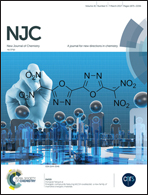Design, structures and study of non-covalent interactions of mono-, di-, and tetranuclear complexes of a bifurcated quadridentate tripod ligand, N-(aminopropyl)-diethanolamine†
Abstract
A series of five new complexes incorporating N-(aminopropyl)-diethanolamine, H2apdea, has been synthesized and characterized by employing elemental, thermal, magnetic, spectroscopic and single crystal X-ray techniques. The reaction of transition metal salts with H2apdea under ambient conditions affords mono-, di- or tetranuclear complexes with the compositions [Ni(H2apdea)(SCN)2]0.5H2O (1), [Co2(Hapdea)(apdea)(SCN)2]NO3·1.5H2O (2), [Co2(Hapdea)(apdea)(H2O)2]3NO3·H2O (3), [Cu2(Hapdea)2(H2O)2]2NO3·2H2O (4) and [Zn4(apdea)2(OCOCH3)2(SCN)2]2MeOH (5). Single crystal X-ray crystallography of 1–5 confirms that the ligand binds to the metal ions in neutral form (H2apdea) in 1, in mono- as well as dianionic form (Hapdea− and apdea2−) in 2 and 3, in monoanionic form (Hapdea−) in 4, and in dianionic form (apdea2−) in 5. Spectral data and crystal structures confirm the distorted octahedral (1–3), square pyramidal (4) and tetrahedral as well as TBP geometries (5) around the metal ions. While 2 and 3 are dinuclear Co(III) systems, the tetranuclear zinc cluster (5) shows interesting structural features with the first example of both two tetrahedral and two TBP Zn(II) centers present in the same molecule. As a result of non-covalent interactions, 1 forms a 2D sheet while 2–5 exist as 3D supramolecular assemblies. A 2D sheet structure is formed due to the presence of S⋯H interactions in 1 (O–H⋯S = 2.518 Å, N–H⋯S = 2.727 Å). Intermolecular O⋯H and S⋯H contacts (C–H⋯O = 2.595 Å, C–H⋯S = 2.894 Å, N–H⋯O = 2.123 and 2.403 Å) along with other H-bonding interactions in 2 generate a 3D supramolecular assembly. Coexistence of a cyclic octamer of oxygen and nitrogen atoms also helps consolidate the architecture in 2. The O⋯H contacts, i.e., O–H⋯O, C–H⋯O and N–H⋯O interactions, play an important role in the aggregation of molecular entities of 3 and 4 to form a 3D supramolecular network. In the case of 5, interactions between the two tetranuclear (Zn4) clusters i.e., N–H⋯C (2.795 Å) and N–H⋯O (2.229 Å) and the interactions formed via lattice solvent molecules (C–H⋯O = 2.495 Å, O–H⋯O = 2.003 Å, O–H⋯C = 2.741 Å) generate a robust 3D supramolecular network. The selected supramolecular interactions (like O⋯H and S⋯H) are further explored using Hirshfeld surface analyses, and electrostatic potential (ESP) and deformation density (DD) calculations.



 Please wait while we load your content...
Please wait while we load your content...